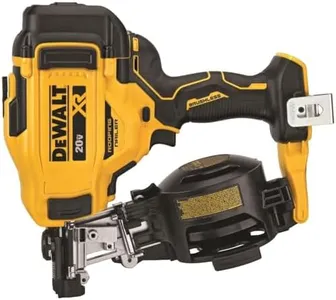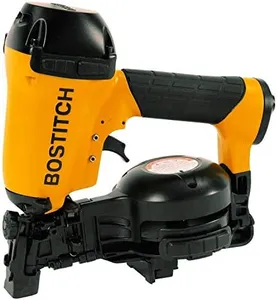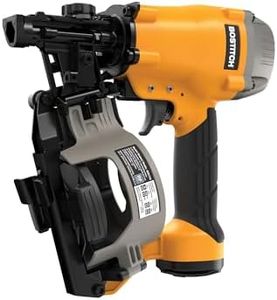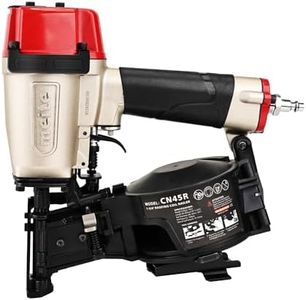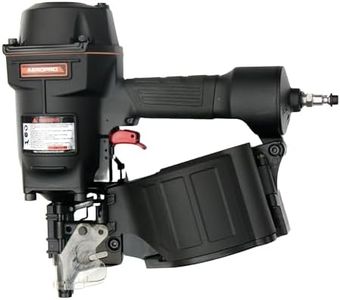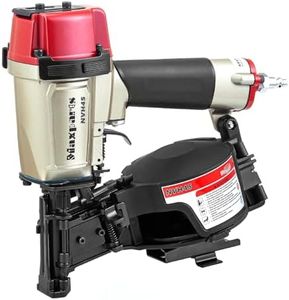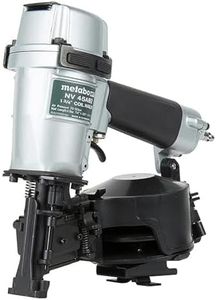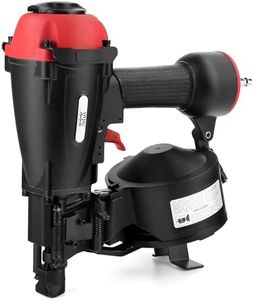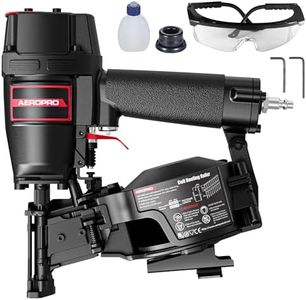We Use CookiesWe use cookies to enhance the security, performance,
functionality and for analytical and promotional activities. By continuing to browse this site you
are agreeing to our privacy policy
10 Best Coil Roofing Nailers
From leading brands and best sellers available on the web.Buying Guide for the Best Coil Roofing Nailers
Choosing a coil roofing nailer is all about finding a tool that matches the scope and style of your roofing projects. Start by thinking about how often you’ll use the tool, the types of materials you work with, and how comfortable the tool should feel in your hand during extended use. The right nailer should feel balanced, deliver consistent performance, and be easy to maintain. Consider the environments you’ll be working in—some nailers handle tough job sites better than others. Also, learn about safety features and think about convenience, like easy loading and jam-clearing mechanisms. If you approach your decision by focusing on how you plan to actually use the nailer, you’ll end up with a tool that serves you well for years to come.Magazine CapacityMagazine capacity tells you how many nails the tool can hold before needing a reload. This is important because a larger magazine lets you work longer without pausing to reload, which can save time on larger roofing jobs. Coil roofing nailers usually have higher capacities than stick nailers, often ranging from about 120 to 300 nails. For frequent, large projects, or when working on big roofs, higher capacity makes more sense. If you’re doing small repairs or occasional work, a standard capacity is usually enough and can make the tool lighter and easier to handle.
Nail Size CompatibilityThis spec refers to the range of nail lengths and thicknesses that the nailer can accommodate. It’s important because different roofing materials and underlayments need different nail sizes for proper fastening. Typical coil roofing nailers use nails from about 7/8 inch to 1-3/4 inches in length. For standard shingles, shorter nails often work, but for thicker materials or certain underlayments, longer nails might be necessary. Be sure to match the nail size range of the nailer to the typical jobs and local building codes you expect to encounter.
Operating Pressure (PSI)Operating pressure, measured in pounds per square inch (PSI), is the air pressure required for the nailer to function properly, as most roofing nailers are pneumatic. This matters because too little pressure can misfire nails, while too much can damage materials or the tool. Most coil roofing nailers operate in the range of 70-120 PSI. Lighter materials or smaller nails often do fine at lower PSI; for heavier work, you might need to dial it up. Make sure your air compressor matches the PSI and volume needed by your nailer for uninterrupted work.
Weight and BalanceWeight tells you how heavy the nailer is, and balance describes how the tool feels in your hand. Both are important for comfort and safety, especially if you work for long stretches or at awkward angles. Lighter nailers (often around 5-6 lbs) reduce fatigue but might not be as sturdy as heavier ones. Heavier models may feel more robust, but can tire you out faster. Try to pick a weight that feels comfortable for the amount of time you plan to use it, and check that the grip and balance feel right for your hand and working style.
Depth AdjustmentThis feature lets you control how deep the nail goes into the roofing material. It matters because different materials require different driving depths for secure fastening without damaging surfaces. Some nailers use tool-free dials or levers for quick adjustments, while others may need tools. Easy depth adjustment is useful if you change materials often or want precise control to prevent overdriving or underdriving nails. If you work with a variety of roofing types, look for a nailer with quick and easy depth change.
Jam Clearing MechanismOccasionally, nails jam in the tool. A jam-clearing mechanism allows you to remove stuck nails quickly and get back to work. This is important because jams can slow down your project and become frustrating. Some nailers offer no-tool jam clearing, making fixes simple and fast on the job site. Others require a screwdriver or more effort. If you want fewer interruptions or are not mechanically inclined, a user-friendly jam clearing feature is a smart choice.
Durability and Build MaterialsThis refers to the overall quality and longevity of the tool. Nailers made with heavier-duty metals and reinforced parts tend to last longer, especially in the tough conditions of roofing jobs. If you expect to use your nailer frequently or in harsh environments (like wet, dusty, or cold conditions), prioritize models with sturdy construction. Occasional or light users might not need maximum durability but should still look for solid build quality to ensure safe and consistent performance.
Trigger Type (Contact vs. Sequential)Trigger type determines how the nailer fires: Contact (bump) triggers allow rapid firing by holding the trigger and bumping the nose on the work surface, while Sequential triggers require a specific sequence—trigger after nose is depressed—for each nail. Contact firing is faster for big jobs, but sequential is safer and more controlled, which can help prevent misfires or accidents. Choose bump firing for speed on larger jobs and sequential if you want more precision and safety while working.

